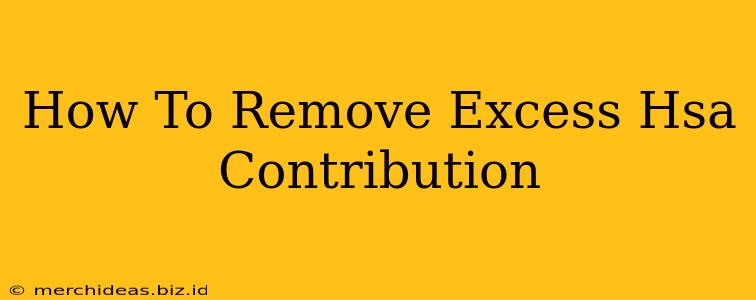Contributing to a Health Savings Account (HSA) is a smart way to save for healthcare expenses tax-free. However, exceeding the annual contribution limit can lead to penalties. Knowing how to remove excess HSA contribution is crucial to avoid these financial setbacks. This guide outlines the steps to take if you've overcontributed to your HSA.
Understanding HSA Contribution Limits
Before we delve into removing excess contributions, let's clarify the contribution limits. These limits are set annually by the IRS and depend on your coverage. Failing to stay within these limits results in an excess contribution. You can find the most up-to-date contribution limits on the IRS website. It's vital to check these limits before contributing to your HSA.
Consequences of Excess Contributions
Over-contributing to your HSA isn't just a minor oversight; it carries significant penalties. The IRS charges a 6% tax on the excess amount each year the excess remains in the account. This penalty can quickly add up, significantly impacting your savings. Therefore, taking corrective action promptly is essential.
Steps to Remove Excess HSA Contribution
The process for removing an excess HSA contribution involves several steps:
1. Determine the Excess Amount
Carefully review your HSA statements and determine the exact amount you've overcontributed. This requires adding up all contributions for the year and comparing it to the IRS-specified limit for your situation. Double-check your calculations to ensure accuracy.
2. Contact Your HSA Provider
Once you've determined the excess, immediately contact your HSA provider. They are your primary resource for guidance on removing the excess contribution. They will provide you with the specific procedures and forms required for your HSA.
3. Distribute the Excess Funds
Your HSA provider will guide you on how to withdraw the excess funds. The removal process typically involves submitting a request form and then receiving the excess contribution back into your designated bank account. Keep a copy of all documentation related to the withdrawal.
4. File an Amended Tax Return (if necessary)
If you've already filed your tax return and discovered the excess contribution, you'll need to file an amended return (Form 1040-X). This amended return will reflect the correction and prevent penalties. The IRS provides instructions on how to file Form 1040-X on their website.
Preventing Future Excess Contributions
Preventing future overcontributions involves proactive measures:
- Track Your Contributions: Maintain a detailed record of all HSA contributions throughout the year.
- Understand the Limits: Familiarize yourself with the annual contribution limits and adjust your contributions accordingly.
- Use HSA Calculators: Many online tools and calculators can help you estimate your contributions and avoid exceeding the limits.
- Regularly Review Statements: Review your HSA statements regularly to ensure accuracy and detect any potential overcontributions promptly.
Key Takeaways:
- Removing an excess HSA contribution requires prompt action to minimize penalties.
- Contact your HSA provider immediately if you suspect an overcontribution.
- Keep accurate records of your contributions to avoid future overcontributions.
By following these steps, you can effectively remove excess HSA contributions and avoid the associated tax penalties. Remember, proactive planning and careful tracking are crucial for maximizing the benefits of your HSA. If you have any doubts or uncertainties, consult with a qualified tax advisor for personalized advice.
